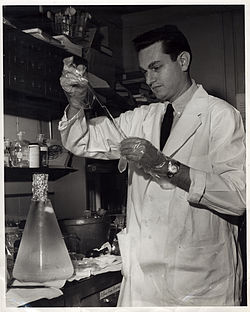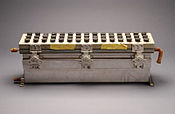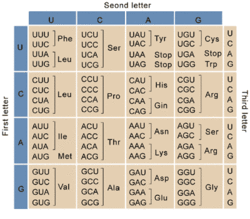- Nirenberg and Leder experiment
-
The Nirenberg and Leder experiment was a scientific experiment performed in 1964 by Marshall W. Nirenberg and Philip Leder. The experiment elucidated the triplet nature of the genetic code and allowed the remaining ambiguities codons in the genetic code to be deciphered.
In this experiment, using a ribosome binding assay, various combinations of mRNA were passed through a filter which contained ribosomes. Unique triplets promoted the binding of specific tRNAs to the ribosome. By associating the tRNA with its specific amino acid, it was possible to determine the triplet mRNA sequence that coded for each amino acid.
Contents
Background
Oswald Avery discovered that the substance responsible for producing inheritable change in the disease-causing bacteria was neither a protein nor a lipid, rather deoxyribonucleic acid (DNA). He and his colleagues Colin MacLeod and Maclyn McCarty suggested that DNA was responsible for transferring genetic information. Later, Erwin Chargaff discovered that the makeup of DNA differs from one species to another. These experiments helped pave the way for the discovery of the structure of DNA. In 1953, with the help of Maurice Wilkins and Rosalind Franklin’s X-ray crystallography, James Watson and Francis Crick proposed DNA is structured as a double helix.[1]
In the 1960’s, one main DNA mystery scientists needed to figure out was in translation how many bases would be in each code word, or codon. Scientists knew there was a total of four bases (guanine, cytosine, adenine, and thymine). They also knew that were 20 known amino acids. George Gamow suggested that the genetic code was made of three nucleotides per amino acid. He reasoned that because there are 20 amino acids and only four bases, the coding units could not be single (4 combinations) or pairs (only 16 combinations). Rather, he thought triplets (64 possible combinations) were the coding unit of the genetic code. However, he proposed that the triplets were overlapping and non-degenerate.[2]
Seymour Benzer in the late 1950s had developed an assay using phage mutations which provided the first detailed linearly structured map of a genetic region. Crick felt he could use mutagenesis and genetic recombination phage to further delineate the nature of the genetic code.[3] In the Crick, Brenner et al. experiment,using these phages, the triplet nature of the genetic code was confirmed. They used frameshift mutations and a process called reversions, to add and delete various numbers of nucleotides.[4] When a nuleotide triplet was added or deleted to the DNA sequence the encoded protein was minimally affected. Thus, they concluded that the genetic code is a triplet code because it did not cause a frameshift in the reading frame.[5] They correctly concluded that the code is degenerate, that triplets are not overlapping, and that each nucleotide sequence is read from a specific starting point.Experimental work
Nirenberg and Leder could not decode the remaining codons in the same manner as Nirenberg did with Mattaei. Because the mRNA bases were taken up at random by the ribosome, it is hard to determine which specific codon correlates with the amino acid. For example, to pick out the correct codon among non repeating codons (UCU, CUU, UUC) is difficult because they couldn't determine the specific sequence.[6] Instead, Leder and Nirenberg used very short artificial RNA sequences (three nucleotides) in the cell-free systems. These shorter length fragments were long enough to allow the ribosome to bind with the type of tRNA molecule that is complementary to the one codon and still be detectable. The key step of the experiment was that they labeled one type of amino acid at a time and then put the mixture through a Millipore filter.[6] This special filter allowed unbound tRNAs to pass through but did not allow the ribosomes with the bound triplet to pass through.[7] The sample was then tested for radioactivity. If there was radioactivity found in the sample that did not pass through the filter the corresponding Amino acid was added.[8]
Reception and legacy
By the Cold Spring Harbor Symposium of 1966, between Nirenberg and Khorana the genetic code was almost completely decoded. Nirenberg was awarded the 1968 Nobel Prize in Physiology or Medicine. He shared the award with Har Gobind Khorana of the University of Wisconsin and Robert W. Holley of the Salk Institute. Working independently, Khorana had mastered the synthesis of nucleic acids, and Holley had discovered the exact chemical structure of transfer-RNA.
The New York Times reported on Leder and Nirenberg's discovery by explaining that "the science of biology has reached a new frontier," leading to "a revolution far greater in its potential significance than the atomic or hydrogen bomb."[2] Most of the Scientific community saw these experiments as highly important and beneficial. However, there were some who were concerned with the new are of Molecular Genetics. For example, Arne Wilhelm Kaurin Tiselius, the 1948 Nobel Laureate in Chemistry, asserted that knowledge of the genetic code could "lead to methods of tampering with life, of creating new diseases, of controlling minds, of influencing heredity, even perhaps in certain desired directions."[9]
References
- ^ Russell P. (2010). iGenetics: A Molecular Approach, 3rd edition. Pearson/Benjamin Cummings.
- ^ a b Leavitt, S. (2004). "Deciphering the Genetic Code: Marshall Nirenberg". NIH. http://history.nih.gov/exhibits/nirenberg/HS3_craze.htm. Retrieved 2009-10-05.
- ^ Yanofsky C. (2007). "Establishing the Triplet Nature of the Genetic Code". Cell 128 (5): 815–818. doi:10.1016/j.cell.2007.02.029. PMID 17350564. http://www.sciencedirect.com/science?_ob=MImg&_imagekey=B6WSN-4N6XNH6-4-1&_cdi=7051&_user=2665120&_coverDate=03%2F09%2F2007&_sk=%23TOC%237051%232007%23998719994%23645906%23FLA%23display%23Volume_128,_Issue_5,_Pages_803-1014_(9_March_2007)%23tagged%23Volume%23first%3D128%23Issue%23first%3D5%23date%23(9_March_2007)%23&view=c&_gw=y&wchp=dGLbVzb-zSkWA&md5=d799cd25cf7ade3221572ad036ad759f&ie=/sdarticle.pdf. Retrieved 2009-10-22.
- ^ Crick F.H.C., Brenner S., Barnett L., and Watts-Tobin R.J. (1961). "General Nature of the Genetic code for Proteins". Nature 192 (4809): 1227–1232. Bibcode 1961Natur.192.1227C. doi:10.1038/1921227a0. PMID 13882203. http://profiles.nlm.nih.gov/SC/B/C/B/J/_/scbcbj.pdf. Retrieved 2009-10-10.
- ^ Matthaei, H.J., Jones, O.W., Martin, R.G., and Nirenberg, M.W. (1962). "Characteristics and Composition of RNA Coding Units". Proceedings of the National Academy of Sciences of the United States of America 48: 666–677. doi:10.1073/pnas.48.4.666. PMC 220831. PMID 14471390. http://www.pubmedcentral.nih.gov/articlerender.fcgi?tool=pmcentrez&artid=220831.
- ^ a b Judson H. (1996). The Eighth Day of Creation: Makers of the Revolution in Biology. Cold Spring Harbor: Cold Spring Harbor Laboratory Press.
- ^ Leder zp. and Nirenberg M.W. (1964). "RNA Codewords and Protein Synthesis, III. On the Nucleotide Sequence of a Cysteine and a Leucine RNA Codeword". PNAS 52: 1521–1529. doi:10.1073/pnas.52.6.1521. PMC 300480. PMID 14243527. http://www.pubmedcentral.nih.gov/articlerender.fcgi?tool=pmcentrez&artid=300480.
- ^ Davies K. (2001). Cracking the Gnome: Inside the Race to Unlock Human DNA. New York: The Free Press.
- ^ Fee, E. (2000). "Profiles in Science: The Marshall W. Nirenberg Papers". NLM. http://profiles.nlm.nih.gov/JJ/Views/Exhibit/narrative/publicreaction.html. Retrieved 2009-10-05.
External links
- Philip Leder's laboratory notebooks, December 1963 to August 1965, can be found at The Center for the History of Medicine at the Countway Library, Harvard Medical School. Digital surrogates are also available through Harvard's HOLLIS catalog.
See also
- Crick, Brenner et al. experiment
- Nirenberg and Matthaei experiment
- List of famous experiments
Categories:- Genetics experiments
- 1964 in science
Wikimedia Foundation. 2010.




